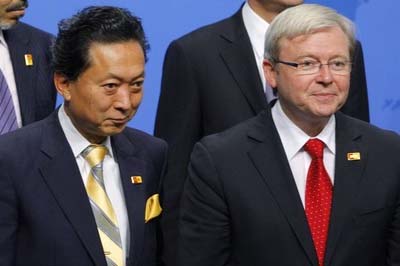Okada described Clinton as ‘not obstinate’ when it came to hearing the DPJ government’s concerns. Okada also told reporters Thursday that the government would begin its own review of plans for replacing Futenma with a facility within Okinawa.
The bigger meeting — bigger in terms of symbolism if not substance — was between Hatoyama Yukio and Barack Obama Wednesday. Obama singled out Hatoyama for praise for ‘running an extraordinary campaign and his party leading dramatic change in Japan.’ He also exhibited his ability to empathize, linking his own experiences in office to the DPJ, saying, ‘I know how it feels to have just been elected and form a government and suddenly you have to appear at a range of international summits; I went through this nine months ago. But I’m very confident that not only will the Prime Minister succeed in his efforts and his campaign commitments, but that this will give us an opportunity to strengthen and renew a U.S.-Japan alliance that will be as strong in the 21st century as it was in the latter half of the 20th century.’ In contrast to some commentators in Washington, Obama delivered an unambiguous message to the DPJ: he recognizes the DPJ’s victory as significant and historic, and will not react with panic just because they have some concerns about the alliance. Not the days of George and Junichiro or Ron and Yasu, but so much the better for the relationship — a much more businesslike partnership. As I’ve argued about Obama in the past, his administration’s focus is on solving problems, whether the problems are within the bilateral relationship or whether it is a matter of what role Japan can play in solving global problems. His administration will listen, it may well yield, but it seems unlikely that the US government will accept the use of the traditional mantras to paper over problems in the relationship.
Sankei suggests that the Obama-Hatoyama meeting was precisely that, papering over problems: the joint statement made no mention, after all, of the problems discussed by Clinton and Okada. This is a silly complaint. When have two leaders at a summit actually used the joint press conference to discuss an unresolved issue that the two governments are in the process of hammering out? And as far as the Japanese government is concerned, the heavy lifting will be done by Okada. No, the summit seems to have went as well as a photo-op summit could go.
But what I find more interesting than the Hatoyama government’s efforts to get the new US-Japan relationship off to a good start is what the Hatoyama government sought to achieve in its Asia policy in New York.
Revealingly, it was not Obama and Hatoyama who referred to each other by their first names but Hatoyama and Australian Prime Minister Kevin Rudd. The two met for forty minutes, and apparently Hatoyama was deeply impressed with Rudd’s knowledge of ‘regime change’ in Japan. While conservatives railed against Hatoyama’s discussions with Chinese President Hu Jintao of an East Asian community, the real story is not the distant dream of an East Asia integrated like the EU but the prospects for partnership between Hatoyama and the leaders of East Asia’s other middle powers, symbolized by the exchange between Hatoyama and Rudd. In the past I noted the affinities between Rudd’s vision for Asia and former Prime Minister Fukuda Yasuo’s. I have also noted the affinities between Fukuda and Hatoyama when it comes to Asia. The point is that greater links among the governments of Japan, Australia, South Korea, and the ASEAN member states are to be expected. These are not the links envisioned by Abe, Bush, and Howard administrations back in 2007, the defunct quadrilateral that included India but not South Korea and that emphasized shared values, democracy, and security cooperation. It is too early to say what precisely will come of greater cooperation among these countries, but given their shared concerns, the relationships will continue to deepen.
Accordingly, there seems to be a tendency among some in Japan to assume that when DPJ officials refer to an ‘Asia-centered’ foreign policy, Asia is a code word for China. But while the Hatoyama government wants a constructive relationship with China — much like its predecessors did — there is clearly more to Asia than China, and more to cooperation in Asia than cooperation with China. Despite Komori Yoshihisa’s alarmism about how an East Asian community will mean the dissolution of Japan, the reality is that an East Asian community that includes all the countries that participate in the East Asian Summit would be a means of ‘enmeshing’ China, much as the ASEAN countries have found ways to cooperate with China while quietly increasing security ties with the US. (See this monograph by Evelyn Goh for more on how Southeast Asian states have maneuvered between the US and China.)

